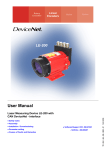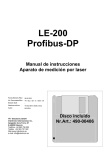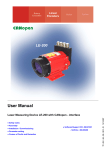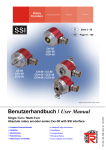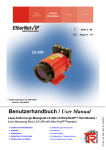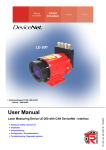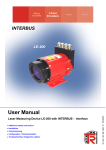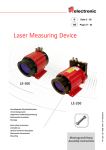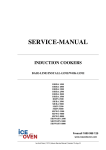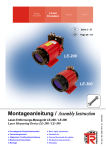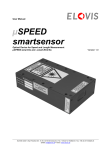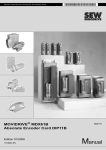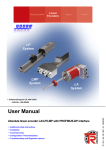Download User Manual - TR Electronic
Transcript
LE-200 User Manual ● Safety notes ● Assembly ● Installation / Commissioning ● Parameter setting ● Trouble elimination and diagnostic possibilities ● Software/Support CD: 490-01001 - Soft-No.: 490-00406 TR - ELE - BA - GB - 0006 - 15 25.03.2008 Laser Measuring Device LE-200 with PROFIBUS-DP and SSI - interface TR-Electronic GmbH D-78647 Trossingen Eglishalde 6 Tel.: (0049) 07425/228-0 Fax: (0049) 07425/228-33 E-mail: [email protected] http://www.tr-electronic.de Copyright protection This Manual, including the illustrations contained therein, is subject to copyright protection. Use of this Manual by third parties in contravention of copyright regulations is forbidden. Reproduction, translation as well as electronic and photographic archiving and modification require the written content of the manufacturer. Offenders will be liable for damages. Subject to amendments Any technical changes that serve the purpose of technical progress, reserved. Document information Release date/Rev. date: Document rev. no.: File name: Author: 25.03.2008 TR - ELE - BA - GB - 0006 - 15 TR-ELE-BA-GB-0006-15.DOC MÜJ Font styles Italic or bold font styles are used for the title of a document or are used for highlighting. Courier font displays text, which is visible on the display or screen and software menu selections. ″< > ″ indicates keys on your computer keyboard (such as <RETURN>). Trademarks PROFIBUS-DP and the PROFIBUS logo are registered trademarks of PROFIBUS Nutzerorganisation e.V. (PNO) [PROFIBUS User Organization] © TR-Electronic GmbH 2007, All Rights Reserved Page 2 of 46 Printed in the Federal Republic of Germany TR - ELE - BA - GB - 0006 - 15 25.03.2008 Revision index Revision index i Note The current revision number and date appears on the front cover of this document. Since the footer of each individual page contains its own revision number and date, the revision status may vary within the same document. The pin assignment, included in the appendix, has its own revision index. Document issued: 12.09.2002 Revision Date • General completions for the usability of the device • Function expansion of the module "Preset" (new: Function ext. input) and "Control bits with acknowledgement" • Correction: Bit 0 = Intensity error, Bit 1 = Device temperature 30.10.2002 Completion of the module "Error Display": 13.12.2002 • Bit 4 = Intensity warning • Additional notes in the technical data for linearized devices • Ordering informations • New GSD file TR040458.GSD - Free resolution in module Position - SSI-Output value in module SSI interface 13.02.2003 • New GSD file TR050458.GSD - Laser-Diode-Operating hours counter 27.03.2003 • New GSD file TR060458.GSD, 08.07.2003 - Function ext. Input: Failure quit • Module Error Display: Implementation of the Speed-check • General technical- and layout modifications • Revision of the warning label in chapter "Intended purpose" New functions in the module "Error Display": • Warning Bit "Fail Plausibility Measured Value" 29.01.2003 25.09.2003 18.12.2003 01.12.2004 © TR-Electronic GmbH 2007, All Rights Reserved Printed in the Federal Republic of Germany 25.03.2008 21.10.2002 TR - ELE - BA - GB - 0006 - 15 Page 3 of 46 Revision index New GSD file: "TR070458.GSE" • New module: "Switching position" • Module "Function external input" renamed in "Function external IO pins" - • Number of SSI bits = 12 – 26 (before: 24 – 26) Text correction in „Module Control Bits With Acknowledgement“: Clear Preset • Completion of the ordering information’s • Correction in „Module Speed“: Default output format = 10mm / sec • Introduction of the Software/Support CD: 490-01001 • Additional reflector foils, chap. Ordering information • Max. measuring range 240 m • 23.01.2006 08.01.2007 28.02.2007 New GSD file: "TR080458.GSE" Correction of the byte sequence for Preset HI/LO word © TR-Electronic GmbH 2007, All Rights Reserved Page 4 of 46 26.02.2005 Module "SSI interface" - • Now the functions of the external output are also programmable over the PROFIBUS (before only via TRWinProg) 18.12.2007 25.03.2008 Printed in the Federal Republic of Germany TR - ELE - BA - GB - 0006 - 15 25.03.2008 Table of Contents Table of Contents Revision index ..................................................................................................................................3 Table of Contents .............................................................................................................................5 1 Safety ..............................................................................................................................................7 1.1 General risk potential.......................................................................................................7 1.2 Safety information............................................................................................................7 1.2.1 Hints on installation..........................................................................................8 1.2.1.1 General interference suppression measures ..................................9 1.3 Intended purpose.............................................................................................................10 1.4 Authorized operators .......................................................................................................12 1.5 Safety measures at the installation site...........................................................................12 2 General Description ......................................................................................................................13 3 Transportation / Storage...............................................................................................................14 4 Assembly instructions ..................................................................................................................15 4.1 Aligning of the laser light spot to the reflector / foil inclination.........................................15 4.2 Parallel operation of laser linear paths ............................................................................17 5 Commissioning / Installation .......................................................................................................18 5.1 Electrical connection........................................................................................................18 5.1.1 Supply voltage .................................................................................................18 5.1.2 Profibus-DP .....................................................................................................18 5.1.2.1 Bus termination ................................................................................19 5.1.2.2 Bus addressing ................................................................................19 5.1.3 SSI interface ....................................................................................................19 5.1.4 Switching input / Switching output ...................................................................19 5.1.5 RS485 - programming interface ......................................................................20 5.1.6 Wiring examples ..............................................................................................20 5.2 SSI interface ....................................................................................................................21 5.3 Profibus-DP interface / Profibus-DP master....................................................................22 5.3.1 Identification number .......................................................................................22 5.3.2 Operating requirements / GSD-file ..................................................................22 5.3.3 Setting the station address ..............................................................................25 5.3.4 Bus termination................................................................................................25 5.3.5 Baud rate .........................................................................................................25 5.3.6 Bus status ........................................................................................................25 6 Configuration / Parameter setting via the Profibus-DP master ................................................26 6.1 Modular configuration ......................................................................................................26 6.2 Module Position ...............................................................................................................27 6.3 Module Speed..................................................................................................................28 6.4 Module Error Display .......................................................................................................28 6.5 Module Switching Position...............................................................................................29 © TR-Electronic GmbH 2007, All Rights Reserved Printed in the Federal Republic of Germany 25.03.2008 TR - ELE - BA - GB - 0006 - 15 Page 5 of 46 Table of Contents 6.6 Module Function External IO Pins ...................................................................................30 6.6.1 Operating parameters......................................................................................30 6.6.1.1 Function ext. input............................................................................30 6.6.1.2 Function ext. output .........................................................................31 6.6.1.3 Preset HI-Word / Preset LO-Word ...................................................32 6.6.1.4 Active slope ext. input ......................................................................33 6.6.1.5 Wait-time to enable ext. input ..........................................................33 6.6.1.6 Active output level............................................................................34 6.7 Module Counter Measuring-Cycle...................................................................................34 6.8 Module SSI interface .......................................................................................................35 6.8.1 Operating parameters......................................................................................35 6.8.1.1 SSI-Data bits....................................................................................35 6.8.1.2 Code.................................................................................................36 6.8.1.3 SSI-Failure bit ..................................................................................36 6.8.1.4 SSI-Output-Value.............................................................................37 6.9 Module Adjustment ..........................................................................................................37 6.10 Module Control Bits With Acknowledgement ................................................................38 6.11 Module Laser-Diode-Operating Hours ..........................................................................39 7 Trouble elimination and diagnostic possibilities.......................................................................40 7.1 How to use the PROFIBUS diagnostics ..........................................................................40 7.1.1 Standard diagnosis ..........................................................................................40 7.1.1.1 Station status 1 ................................................................................41 7.1.1.2 Station status 2 ................................................................................41 7.1.1.3 Station status 3 ................................................................................41 7.1.1.4 Master address ................................................................................41 7.1.1.5 Manufacturer's identifier...................................................................41 7.2 Other troubles ..................................................................................................................42 7.2.1 Causes of Faults and Remedies .....................................................................42 8 Maintenance...................................................................................................................................43 8.1 General Maintenance Information ...................................................................................43 8.2 Repair, Maintenance .......................................................................................................43 9 Appendix ........................................................................................................................................44 9.1 Specifications...................................................................................................................44 9.1.1 Electrical ratings ..............................................................................................44 Profibus-DP Interface...................................................................................44 9.1.2 Environmental conditions ................................................................................45 9.2 Ordering information........................................................................................................46 9.2.1 Laser devices...................................................................................................46 9.2.2 Accessories .....................................................................................................46 Pin Assignment..........................................................................................TR-ELE-TI-GB-0007 Drawings Dimensioned drawing ............................................................................. 04-K2200-002 © TR-Electronic GmbH 2007, All Rights Reserved Page 6 of 46 Printed in the Federal Republic of Germany TR - ELE - BA - GB - 0006 - 15 25.03.2008 Safety 1 Safety 1.1 General risk potential The Laser Measuring Device LE-200 Profibus-DP cannot be operated independently, but is installed as part of an overall system usually consisting of several interacting components. For this reason, the laser measuring device is not equipped directly with a protective device. Warning The corresponding measures must be taken in order to avoid person and property damages! However, different error reports can be read out via an error message, see 6.4 page 28. It is therefore essential to integrate the module "Error-Display" into your own safety system via the evaluation software (e.g. a PLC). All persons responsible for the assembly, start-up and operation of the device must • be suitably qualified • adhere strictly to this operating manual. Your safety and the safety of your equipment depends on this! 1.2 Safety information This operating manual contains information which must be observed in the interests of your own personal safety and that of your equipment. The safety hints are emphasized by a warning triangle and classified according to the degree of danger as follows: Warning means that failure to take the relevant safety precautions can lead to serious damage to property or injuries. i Note refers to important information and features of the product, plus tips on its application. © TR-Electronic GmbH 2007, All Rights Reserved Printed in the Federal Republic of Germany 25.03.2008 TR - ELE - BA - GB - 0006 - 15 Page 7 of 46 Safety 1.2.1 Hints on installation Since the Laser Measuring Device is normally used as part of a larger system, these hints are merely intended as a guide for integrating the device safely into its environment. Warning • During the operation of the Laser Measuring Device it isn't allowed to interrupt the laser beam. If it comes nevertheless to an interruption, at the restart of the automatic operation mode first the validity (plausibility) of the measured value has to be checked. • Precautionary measures must be taken to allow an interrupted program to be properly resumed following a voltage drop or failure. Dangerous operating conditions must not be permitted to arise even for short periods. If necessary, an "EMERGENCY STOP" must be forced. • EMERGENCY STOP devices according to EN 60204/IEC 204 (VDE 0113) must remain operational in all operating modes of the programmable controller. The release of the EMERGENCY STOP devices must not trigger an uncontrolled or undefined reactivation of the equipment. • The safety and accident prevention regulations applicable to the specific application must be observed. • In the case of permanently installed plants or systems without an all-pole mains switch and/or fuses, one of these devices must be installed accordingly and the equipment connected to a PE conductor. • In the case of 24 V supplies, make sure the extra-low voltage is reliably disconnected. Only use power supply units manufactured to the standards IEC 364 - 4 - 41 / HD 384.04.41 (VDE 0100 Part 410). • Fluctuations or deviations of the supply voltage from the nominal value must not exceed the tolerance limits stated in the specifications, otherwise operational failures and dangerous states in the electrical assemblies cannot be ruled out. • Connecting and signal wires must be installed in such a way as to prevent the automation functions from being hampered by inductive and capacitive interference. • The units of the automation system and their operating elements must be installed in such a way as to ensure adequate protection against accidental actuation. • In order to prevent a wire or strand breakage on the signal side from causing undefined states in the programmable controller, suitable hardware and software safety precautions must be taken with regard to the I/O interface. © TR-Electronic GmbH 2007, All Rights Reserved Page 8 of 46 Printed in the Federal Republic of Germany TR - ELE - BA - GB - 0006 - 15 25.03.2008 Safety 1.2.1.1 General interference suppression measures • Lay the (shielded) connecting cable to the device at a sufficient distance or in a separate room from any power cables which are subject to interference. Otherwise the data transmission of the measured value can be interfered. • To ensure reliable data transmission, use fully shielded cables and make sure they are well earthed. For differential data transfer (SSI, Profibus), twisted-pair wires must be used in addition. For the Profibus absolutely the installation requirements (bus cable, line length, shielding etc.) specified in the EN 50170 standard are to be considered. • Use a minimum cable cross-section of 0.22 mm2 for data transfer purposes. • Use a minimum earthing cable (machine base) cross-section of 10 mm2 in order to avoid equipotential currents across the shield. Make sure the resistance of the earthing cable is much lower than that of the shield. • Avoid crossing cables where possible. If unavoidable, only cross them at right-angles. • Ensure continuous wiring of the shield and a large contact area on special shield clampings or cable screw glands, see Figure 1 point (A) and (B). B ERR OK RUN A 23 9 01 9 23 456 78 78 456 01 Figure 1: Connection cap with cable screw glands and shield clampings Shield connection via cable screw glands: 1. Screw the cable screw gland into the housing. 2. Dismount the compression nut (1) and the terminal holder (2). 3. Push the compression nut (1) and the terminal holder (2) over the cable. 4. Strip the cable; push back the braiding around the terminal holder (2) such that the braiding goes over the inner O-ring (3) and does not lie over the cylindrical section or the torsional bars. 5. Insert the terminal holder (2) into the intermediate gland (4) such that the torsional bars fit into the intended lengthwise grooves in the intermediate gland (4). 6. Screw the compression nut (1) to the intermediate gland (4). Element 2 Terminal holder Element 3 inner O-ring Element 4 Intermediate gland © TR-Electronic GmbH 2007, All Rights Reserved Printed in the Federal Republic of Germany 25.03.2008 Element 1 Compression nut TR - ELE - BA - GB - 0006 - 15 Page 9 of 46 Safety 1.3 Intended purpose The measuring system is used for recording linear movements and processing the measured data for a downstream control system with a PROFIBUS-DP- or SSIinterface. Particularly the measuring system is designed for the use of distance measurements for the detection of the position and positioning of: ! ! ! ! High-bay storage devices and lifting gears Crane systems Side-tracking skates and truck storage vehicles Transfer machines Warning Switch off the voltage supply before carrying out wiring work or opening and closing electrical connections! Short-circuits, voltage peaks, etc. can cause operating failures and uncontrolled operating states, as well as serious personal injuries and damage to property. Check all electrical connections before switching on the system! Incorrectly wired connections can cause operating failures, while wrong connections can lead to serious personal injuries and damage to property. Mechanical or electrical modifications to the measuring systems are prohibited for safety reasons! In particular the following uses are forbidden operation in areas where interruption of the laser beam, e.g. by covering the laser lens opening, can lead to equipment damage or injury to personnel - in environments, in which strong rain, snow, fog, steams or direct insolations etc. can influence the laser beam intensity negatively - operation in rooms with explosive atmospheres - operation for medical purposes With use-purposes larger 125m measuring length, a special reflector must to be used! (see chapter "Accessories", page 46) © TR-Electronic GmbH 2007, All Rights Reserved Page 10 of 46 Printed in the Federal Republic of Germany TR - ELE - BA - GB - 0006 - 15 25.03.2008 Safety Warning Laser Light Do not stare into the beam Laser Class 2 P max = 1 mW, λ = 670 nm DIN EN 60825-1: 2003-10 Complies with 21 CFR 1040.10 and 1040.11 except for deviations pursuant to laser notice No. 50, July 2001 • In the case of Class 2 laser devices, the eye is not endangered if the exposure of the laser radiation is very short (up to 0.25 s) and accidental. For this reason, devices of this class can be used without additional protective measures, provided for the application it is not necessary to look into the laser beam deliberately for longer periods, i.e. 0.25 s, or to look repeatedly into the laser beam itself or the specular reflected beam. The existence of the blinking reflex for the protection of the eyes may not be assumed. Therefore the eyes should be closed consciously, or the head should be turned away immediately! • The device must be installed in such a way that the exposure of persons to the laser beam can only happen accidentally. • The laser beam may only extend as far as is necessary for the range measurement. The beam must be limited at the end of the useful range by a diffusely reflecting target area in such a way as to minimize the danger from direct or diffuse reflection. For this purpose, you should use the TR-Electronic reflecting foil supplied with the device. • The area outside the operating range where the unshielded laser beam falls should be limited as far as possible and should remain out of bounds, particularly in the area above and below eye level. • Observe the legal and local regulations applicable to the operation of laser units. i Note The start-up, operating and programming instructions contained in this manual are mandatory. © TR-Electronic GmbH 2007, All Rights Reserved Printed in the Federal Republic of Germany 25.03.2008 TR - ELE - BA - GB - 0006 - 15 Page 11 of 46 Safety 1.4 Authorized operators The start-up and operation of this device may only be performed by qualified personnel. For the purposes of this manual, the term "qualified personnel" refers to persons who are authorized to operate, earth and label equipment, systems and power circuits according to recognized safety standards. 1.5 Safety measures at the installation site Warning Do not perform any welding work once the device is connected and switched on! Variations in potential can destroy the device or restrict its operation. Do not touch plug contacts with your hands! Static charges may destroy electronic components of the device. Do not connect unused inputs (see pin assignment)! Observe the voltage supply range: Standard device: 18-27 V DC (± 5 %) Device with heating: 24 V DC (± 5 %) Clean lens opening of the laser and the reflecting foil regularly! (see chapter "Maintenance", page 43) i Note Make sure that the environment of the installation site is protected against corrosive media (acids, etc.) © TR-Electronic GmbH 2007, All Rights Reserved Page 12 of 46 Printed in the Federal Republic of Germany TR - ELE - BA - GB - 0006 - 15 25.03.2008 General Description 2 General Description The laser measuring devices of the series LE are optical sensors, with which larger distances can be measured without contact and serviceable for controller. The measuring system consists of the real measuring device with laser light source, receiving optics, electronic evaluation and data interface as well as a reflector. The device sends out a modulated light beam which is reflected by the reflector. From the phase difference of the sent and received light beam the distance is measured 1000 times per second. Thus the LE is suitable also directly for the position feedback in controller loops. According to the requirements the laser distance measuring devices of the series LE-200 Profibus-DP are configured either directly over the Profibus-DP or with the PC-programming software "TRWinProg". Principle Receiver signal ϕ Transmitter signal ϕ = Phase displacement Reflecting foil d = Distance d = f(ϕ) Measuring start 0,2m Measuring end Display range max. 240m (Special Device) 125m © TR-Electronic GmbH 2007, All Rights Reserved Printed in the Federal Republic of Germany 25.03.2008 Measuring range TR - ELE - BA - GB - 0006 - 15 Page 13 of 46 Transportation / Storage 3 Transportation / Storage Transport instructions Do not drop the device or expose it to shocks or vibrations! Device contains an optical system with glass elements. Only use the original packaging! The wrong packaging material can cause damage to the device during transportation. Storage Storage temperature : -20 to +75°C Store in dry conditions. © TR-Electronic GmbH 2007, All Rights Reserved Page 14 of 46 Printed in the Federal Republic of Germany TR - ELE - BA - GB - 0006 - 15 25.03.2008 Assembly instructions 4 Assembly instructions The adjustment of the laser measuring device in the vertical plain is carried out via four studs (A) in the mounting plate. The adjustment in the horizontal plane can be made by four hexagon bolts (B). It has to be taken into account that the screw diameter is approx. 1-2 mm smaller than the through bore of the mounting plate. Exact dimensional properties are on the dimensional drawing in the rear part of the document. B A Figure 2: Mechanical adjustment possibilities 4.1 Aligning of the laser light spot to the reflector / foil inclination i The measuring device or reflector is attached to the moving object and the reflector/sensor to the fixed remote station in such a way that the reflector always remains within the visual field of the sensor. This can be done using the light spot of the laser diode, which is still clearly visible on the reflecting foil even at long distance. When aligning the laser measuring device, the user may need to take measures to ensure that it can be mechanically adjusted. The size of the reflecting foil must be such that the light spot cannot be displaced from the reflector by vibrations. Since with an increasing distance the light spot gets larger and larger, the edge areas of the foil also have to be avoided. The device comes with a reflecting foil measuring 20 x 20 [cm], but other sizes can be ordered on request. Note Reflecting foils by other manufacturers should not be used under any circumstances, as all the information in the "Specifications" chapter refers to the foil already supplied with the device. © TR-Electronic GmbH 2007, All Rights Reserved Printed in the Federal Republic of Germany 25.03.2008 TR - ELE - BA - GB - 0006 - 15 Page 15 of 46 Assembly instructions Procedure: • Figure 3: Detection of the surface reflectivity: At first attaching the reflector foil flatly and drive plant on minimal distance Laser – Foil. Centering paper (C) in front of the laser optics so, that the laser beam can unhinderedly emerge by an approx. 2 cm hole. Now, the interfering signal (B) should get visible on the paper (C). To the better location of the interfering signal (B) the reflector foil can be moved also a little. Here it is valid: angle of incidence = angle of reflection • Figure 4: Transmitting away the surface reflectivity: Rotate the reflector foil in the Y- or in the Z-axis so, that the interference signal (B) always is outside the laser lens. Nevertheless keeping the inclination of the reflector foil as low as possible to minimize measuring errors caused by misalignments in the procedure movement. For example, if the light spot drifts on the reflector foil around, small differences arise as a result of the oblique position. Fix reflector foil (A) real wanted signal, is always thrown back 180° independently of the reflector inclination Figure 3: Detection of the surface reflectivity (B) Surface reflectivity (interference signal) (C) Paper with an approx. 2 cm large hole in the center Figure 4: Transmitting away the surface reflectivity © TR-Electronic GmbH 2007, All Rights Reserved Page 16 of 46 Printed in the Federal Republic of Germany TR - ELE - BA - GB - 0006 - 15 25.03.2008 Assembly instructions 4.2 Parallel operation of laser linear paths It has to be taken care in the parallel operation of laser linear paths that a minimum distance of 1 m is kept. The reflector foil inclination must be made in such a way that the surface reflectivity (see arrows) points not into the other laser linear path. The alignment is carried out as described in chapter 4 / 4.1. Figure 5: Minimum distance in parallel operation © TR-Electronic GmbH 2007, All Rights Reserved Printed in the Federal Republic of Germany 25.03.2008 TR - ELE - BA - GB - 0006 - 15 Page 17 of 46 Commissioning / Installation 5 Commissioning / Installation 5.1 Electrical connection i Note At the realization of the electrical connection the references in chapter 1.2.1, starting from page 8 must be considered. In order to be able to carry out the connection, the connection cap must be removed from the laser first. For this the screws (A) are loosened and the cap (B) is removed away from the laser. ERR OK RUN B A 15 1 A 23 9 01 9 23 456 78 78 456 01 5.1.1 Supply voltage Pin 10 Standard: 18 – 27 V DC Device with heating: 24 V DC (±5%) 15 14 13 12 11 10 9 8 7 6 5 4 3 2 1 Pin 11 0V, GND 5.1.2 Profibus-DP Simultaneous use of the Profibus DP- and SSI - interface possible. Pin 1 Profibus Data PB_A_IN Pin 2 Profibus Data PB_B_IN Pin 3 Profibus Data PB_A_OUT Pin 4 Profibus Data PB_B_OUT © TR-Electronic GmbH 2007, All Rights Reserved Page 18 of 46 15 14 13 12 11 10 9 8 7 6 5 4 3 2 1 Printed in the Federal Republic of Germany TR - ELE - BA - GB - 0006 - 15 25.03.2008 Commissioning / Installation 5.1.2.1 Bus termination 15 14 13 12 11 10 9 8 If the laser measuring device is the last slave in the Profibus segment, the bus line is to be terminated by the termination switches = ON. 7 6 5 4 3 2 1 Termination 23 23 9 01 1 ON OFF 9 01 10 456 78 78 456 10 0 5.1.2.2 Bus addressing 15 14 13 12 11 10 9 8 7 6 5 4 3 Valid Profibus addresses: 3 – 99 2 1 Termination 0 10 : Setting of the units position 23 9 01 01 1 10 ON OFF 9 23 456 78 78 456 1 10 : Setting of the decimal position 10 0 5.1.3 SSI interface Simultaneous use of the SSI- and Profibus DP - interface possible. Pin 12 Pin 13 Pin 14 Pin 15 SSI-Clock + SSI-Clock – SSI-Data + SSI-Data – 15 14 13 12 11 10 9 8 7 6 5 4 3 2 1 5.1.4 Switching input / Switching output The programming of the switching input /switching output is carried out either directly via the bus, or via the PC software "TRWinProg". Functions of the switching input: - Preset, - Switch off laser diode, - Failure quit Functions of the switching output: - Temperature- , - Intensity- , - Hardware-Fail-Output , - every fail - Speed-check, Plausibility measured value, Switching output position Pin 5 Pin 6 Pin 7 Switching input Switching output GND, reference potential pin 6 © TR-Electronic GmbH 2007, All Rights Reserved Printed in the Federal Republic of Germany 25.03.2008 15 14 13 12 11 10 9 8 7 6 5 4 3 2 1 TR - ELE - BA - GB - 0006 - 15 Page 19 of 46 Commissioning / Installation 5.1.5 RS485 - programming interface The RS485 programming interface was developed mainly only as service interface for the technician. Primarily therefore the programming possibilities via the Profibus-DP should be used. Via the PC software "TRWinProg" and a PC adapter the connection to the laser measuring device is established. More informations see below or in the TRWinProg software manual. Pin 8 RS485+ Pin 9 RS485– 15 14 13 12 11 10 9 8 7 6 5 4 3 2 1 5.1.6 Wiring examples * Shield connection, see chapter 1.2.1.1 page 9. Profibus connection incoming Profibus * LE-200 1 2 3 outgoing Profibus * 4 5 6 7 Profibus Data PB_A_IN Profibus Data PB_B_IN Profibus Data PB_A_OUT Profibus Data PB_B_OUT Switching Input, programmable Switching Output, programmable GND, reference potential pin 6 8 9 10 11 Supply Voltage 0V, GND SSI-connection with parameter setting via "TRWinProg" © TR-Electronic GmbH 2007, All Rights Reserved Page 20 of 46 Printed in the Federal Republic of Germany TR - ELE - BA - GB - 0006 - 15 25.03.2008 Commissioning / Installation 5.2 SSI interface The Laser Measuring Device is equipped with an SSI data interface, i.e. the data are transmitted via the synchronous/serial technique. The SSI technique is a synchronous/serial transfer process for the encoder positions, and has become more or less standard for absolute encoders. Using the RS422 interface makes it possible to obtain sufficiently high transfer rates. The device operates at a clock rate of 80 kHz to 820 kHz max. The transfer process works as follows: the user transmits bundles of clock pulses via the clock-pulse lines. With every incoming pulse, the device returns the information in its shift register bit by bit to the transmitter via the data lines, starting with the most significant bit. The last data bit is followed merely by zero bits. In the interval between the bundles, "1" bits are sent. The interval is detected by a re-triggerable monoflop. Only then can a new bundle begin. The mono-time is 20µs. Because the data transfer is synchronized by the start of the bundle, it is not necessary to use one-step codes such as Gray code. In the example below, the receiver reads the value 001 0111 0011 1101 0011 0010 (HEX 173D32) as the encoder position. Clock+ Clock- Data+ 4V Data- Clock+ Data+ Monoflop time that can be seen when lowest encoder bit = 0 i Lowest encoder bit from 0 to 1 Note Since this transmission technique affords no protection against faulty transfer data, it is essential to use well shielded twisted-pair cables. © TR-Electronic GmbH 2007, All Rights Reserved Printed in the Federal Republic of Germany 25.03.2008 TR - ELE - BA - GB - 0006 - 15 Page 21 of 46 Commissioning / Installation 5.3 Profibus-DP interface / Profibus-DP master 5.3.1 Identification number The Laser Measuring Device has the PNO ID number 0458 (hex). This number is reserved and filed with the PNO. 5.3.2 Operating requirements / GSD-file Theoretically, the Laser Measuring Device can be connected to any Profibus-DP network, provided the PROFIBUS-DP master is capable of transmitting a parameter message. Similarly, the configuration software should be able to display the parameter structure specified in the device master file in order to allow the parameters to be entered. If this is not the case, the Laser Measuring Device can not be put into operation. TR-Electronic supplies a CD containing the device master file (.GSD). If the CD is not enclosed with this documentation, it can be ordered quoting reference number 490-01001. The Soft-No. for the fieldbus files is 490-00406. The current device master file of the Laser has the filename TR070458.GSD, dated from 23.02.2005. The Laser Measuring Device also has two bitmap files named TR_0458N.BMP and TR_0458S.BMP which represent the Laser Measuring Device in the normal and faulty states respectively. For details of how to integrate the files (*.GSD, *.BMP) into the system configuration, please refer to the relevant documentation of the configuration program for the Profibus master. Overview of the previous device master file versions: GSD file: Device type: Entry hardware catalogue: Version no.: Comment: GSD file: Device type: Entry hardware catalogue: Version no.: Comment: GSD file: Device type: Entry hardware catalogue: Version no.: Comment: TR010458.GSD, 12/01/99 LE-100 TR LE100 DP 1 Base version device type LE-100. TR020458.GSD, 14/02/2001 LE-100 TR LE100 DP 2 Functional expansion: ! Module "Adjustment", ! Module "Control Bits With Acknowledgement" TR030458.GSD, 14/10/2002 LE-200 TR LE200 DP 2 Base version device type LE-200 Continuation see next page © TR-Electronic GmbH 2007, All Rights Reserved Page 22 of 46 Printed in the Federal Republic of Germany TR - ELE - BA - GB - 0006 - 15 25.03.2008 Commissioning / Installation GSD file: Device type: Entry hardware catalogue: Version no.: Comment: GSD file: Device type: Entry hardware catalogue: Version no.: Comment: GSD file: Device type: Entry hardware catalogue: Version no.: Comment: TR040458.GSD, 12/02/2003 LE-200 TR LE200 DP 3 Functional expansion: ! Parameter "Free resolution" in module Position ! Parameter "SSI output value" in module SSI interface Compatibility to LE-100 device master file TR020458.GSD: Generally, a compatible operation with LE-100 DP-projects is problemfree possible. However the following restrictions must be made: ! The module "Control Bits" may not be used, instead of its, the module "Control Bits With Acknowledgement" is to be used. ! The module "Signal Bits" may not be used ! The following parameters are not evaluated and have therefore no influence: Parameter "Initial value" in module "Position" - Parameter "Input" in module "Error Display" - Parameter "26-bit-repetition" and values" in module "SSI interface" "Negative TR050458.GSD, 27/03/2003 LE-200 TR LE200 DP 5 Functional expansion: ! Module "Laser-Diode-Operating hours counter" Compatibility to LE-100 device master file TR020458.GSD: see comment device master file "TR040458.GSD" TR060458.GSD, 08/07/2003 LE-200 TR LE200 DP 6 Functional expansion: ! Module "Function ext. Input": - Failure quit Compatibility to LE-100 device master file TR020458.GSD: see comment device master file "TR040458.GSD" © TR-Electronic GmbH 2007, All Rights Reserved Printed in the Federal Republic of Germany 25.03.2008 TR - ELE - BA - GB - 0006 - 15 Page 23 of 46 Commissioning / Installation GSD file: Device type: Entry hardware catalogue: Version no.: TR070458.GSD, 23/02/2005 LE-200 TR LE200 DP 7 Functional expansion / Adaptation: ! New: Module "Switching position" ! The module "Function ext. input" was renamed in "Function ext. IO pins". Now this module contains all features to program the external switching output also over the PROFIBUS. ! Module "SSI interface": So far the number of SSI-data bits were programmable from 24 - 26. New: 12 – 24 Comment: Compatibility to LE-100 device master file TR020458.GSD: see comment device master file "TR040458.GSD" GSD file: Device type: Entry hardware catalogue: Version no.: Comment: TR080458.GSD, 14/03/2008 LE-200 TR LE200 DP 8 Correction of the byte sequence: ! Module "Function External IO Pins": - Preset HI/LO word, byte sequence 4, 6 --> 3, 5 Compatibility to LE-100 device master file TR020458.GSD: see comment device master file "TR040458.GSD" © TR-Electronic GmbH 2007, All Rights Reserved Page 24 of 46 Printed in the Federal Republic of Germany TR - ELE - BA - GB - 0006 - 15 25.03.2008 Commissioning / Installation 5.3.3 Setting the station address The station address of the Laser Measuring Device is set exclusively via the rotary switches which becoming visible after removing the cover: 15 14 13 12 11 10 9 8 7 6 5 4 3 100: Setting of the units position 101: Setting of the decimal position Termination 23 9 01 01 1 10 ON OFF 9 23 456 78 456 78 The addressing of the Laser Measuring Device is limited within the Profibus address area. Valid station addresses are 3 - 99. If an invalid station address is set, the device will not start up! 2 1 10 0 5.3.4 Bus termination 7 6 5 4 3 2 1 Termination 23 23 9 01 01 10 456 1 ON OFF 9 456 78 In this case the outgoing bus line (PB_A_OUT, PB_B_OUT) is interrupted! 15 14 13 12 11 10 9 8 78 All PROFIBUS networks must be terminated by a resistor at the ends of the bus segments. The termination resistor and resistors for connecting to the data reference potential are located in the bus cap with the terminals, and can be connected via DIL-switches if necessary, provided the Laser Measuring Device is the last station of a bus segment. 10 0 5.3.5 Baud rate The Baud rate at which the PROFIBUS is operated may lie within the range of 9.6 kBaud to 12 Mbaud, and is detected automatically by the Laser Measuring Device. 5.3.6 Bus status At the connection cap the laser has 3 LEDs, which display the bus status of the laser: ERR OK RUN RUN ERR OK (green): Profibus-DP active (red): flashing = Profibus-DP not active, static = hardware failure (green): Hardware ok © TR-Electronic GmbH 2007, All Rights Reserved Printed in the Federal Republic of Germany 25.03.2008 TR - ELE - BA - GB - 0006 - 15 Page 25 of 46 Configuration / Parameter setting via the Profibus-DP master 6 Configuration / Parameter setting via the Profibus-DP master The configuration of the laser occurs alternatively via the configuration software of the Profibus-DP - master or via the TRWinProg-software. With a download of the control parameters the parameters, which were configured via the TRWinProg-software, will be overwritten by the control. In this instruction only the configuration via the Profibus-DP - master is described. The PC program TRWinProg is described in an instruction of its own. 6.1 Modular configuration Since all functions of the Laser Measuring Device are used not at any time, individual functions can be disabled on the bus. For this, in the mask of configuration software of the Profibus master, the Laser Measuring Device is represented as a modular compact device . That means after insertion of the laser into the configuration list of the master, the corresponding configuration list at first is empty. Every module requires inputs and outputs and has a parameter data set. The parameter data set must be set dependent of the application. That the laser starts at the Profibus, in the configuration list at least one module must be entered. i Important note: It exist configuration programs which include an "universal module". This module is not defined in the device master file of the laser and must not be used. © TR-Electronic GmbH 2007, All Rights Reserved Page 26 of 46 Printed in the Federal Republic of Germany TR - ELE - BA - GB - 0006 - 15 25.03.2008 Configuration / Parameter setting via the Profibus-DP master 6.2 Module Position The module uses two input words which are consistently transferred via the bus. The position of the Laser Measuring Device is transferred via these two input words. Position of the I/O data in the input double word ID x Data byte 3 Data byte 2 Data byte 1 Data byte 0 MSB LSB Input byte x+0 Input byte x+1 Input byte x+2 Input byte x+3 corresponding parameter data: Resolution Sets the resolution of the measurement system. The available options are : Centimeter Millimeter (default) 1/10 millimeter 1/100 millimeter Inch 1/10 inch * Free resolution (in 1/100 mm), valid values are 1 - 65535, default = 100 * As of GSD file TR040458.GSD (12.02.2003) Freely selectable resolution, by input of the corresponding data value. If e.g. a resolution shall be adjusted of 1 mm, you must type in the data value 100. Count direction Sets the count direction of the measurement system. The available options are : positive (default) position values increasing negative position values decreasing © TR-Electronic GmbH 2007, All Rights Reserved Printed in the Federal Republic of Germany 25.03.2008 TR - ELE - BA - GB - 0006 - 15 Page 27 of 46 Configuration / Parameter setting via the Profibus-DP master 6.3 Module Speed The module uses one input word which is consistently transferred via the bus. Here the momentary actual speed is output. About the PC program TRWinProg the output format can be determined: • 10 mm/s = 0.01 m/s, Default • 1 mm/s = 0.001 m/s Input word IW x Data byte 1 Data byte 0 MSB LSB Input byte x+0 Input byte x+1 6.4 Module Error Display The module uses 1 input byte, which is coded bit by bit. Over the input byte the error message of the laser will transfer and is reset, if the error were recovered, or is no more present. No error Input byte = 0x00 Corresponds to the normal condition Intensity Bit 0 in the input byte The bit is set, if an intensity value of smaller 8% is present, or the laser beam is interrupted and leads to the error value output. Temperature Bit 1 in the input byte The bit is set, if the device temperature is outside of the range from 0 - 50 °C. A low range deviation has still no influence on the measurement and is therefore to be regarded as a warning. Hardware Bit 2 in the input byte The bit is set, if an internal hardware error or a station address < 3 were detected and leads to the error value output. Laser diode switched off Bit 3 in the input byte The bit is set, if the laser diode was switched off over the bus, or the switching input. Serves only for information purposes. Intensity warning Bit 4 in the input byte The bit is set, if an intensity value of smaller 12% were determined and means that the measuring system optics, or the reflecting foil is to be cleaned. However, the device operates error-freely furthermore. Overspeed warning Bit 5 in the input byte The bit is set if the speed, adjusted in the PC program TRWinProg, is exceeded. About the default setting the speed-check is switched off. A configurability over the bus is not possible. Warning bit Plausibility Bit 6 in the input byte The bit is set if the plausibility of the measured value cannot be guaranteed. E.g. this is the case at a position jump if a second reflection foil is held into the laser beam. © TR-Electronic GmbH 2007, All Rights Reserved Page 28 of 46 Printed in the Federal Republic of Germany TR - ELE - BA - GB - 0006 - 15 25.03.2008 Configuration / Parameter setting via the Profibus-DP master corresponding parameter data: Error value It determines which data value should be transmitted in the module position in the case of an error. The data value is output, if the laser can output no more measurement. This is given e.g., if a beam interruption is present. The available options are : Null (default) The position is set to "0" 0xFF All 24 bits are set to '1' (0xFFFFFF or -1) last valid value Output of the last valid position 6.5 Module Switching Position Starting from GSD file TR070458.GSD / 23.02.2005 The module uses two output words which are consistently transferred via the bus. The module specifies the position value, on which the switching output is switched actively, when the function "Switching output position" (see "Function ext. output" page 31) is preselected. Below this switching position the switching output is inactive. Position of the I/O data in the output double word OD x Data byte 3 Data byte 2 Data byte 1 Data byte 0 MSB LSB Output byte x+0 Output byte x+1 Output byte x+2 © TR-Electronic GmbH 2007, All Rights Reserved Printed in the Federal Republic of Germany 25.03.2008 Output byte x+3 TR - ELE - BA - GB - 0006 - 15 Page 29 of 46 Configuration / Parameter setting via the Profibus-DP master 6.6 Module Function External IO Pins The module uses no inputs and no outputs and is only used for the parameterization of the function for the external input/output at the Laser Measuring Device. Overview of operating parameters Parameter Data type Relative byte-address Range of values (dec.) Function ext. input unsigned8 0 0–3 Function ext. output unsigned8 1 0–7 Preset HI-Word unsigned16 2–3 0 – 65 535 Preset LO-Word unsigned16 4–5 0 – 65 535 Active slope ext. input unsigned8 6 0–1 Wait-time to enable ext. input unsigned8 7 0–3 Active output level unsigned8 8 0–1 6.6.1 Operating parameters 6.6.1.1 Function ext. input Definition of the function for the external switching input. DDLM_Set_Prm unsigned8 Rel. byte address Bit Data Default (dec.) Value Assignment 0 1 2 0 7–0 27 – 2 0 0 Description Disabled Function switched off, following parameters without meaning. Preset-function With connection of the switching input or by executing the control bit "Execute Preset" in the module "Control bits with quit", the laser is adjusted to the predefined position value (Preset HI- and LO-Word). LD-switch-input With connection of the switching input the laser diode is switched off for the extension of the life time. If in the PCprogram "TRWinProg" in the basic parameters the switchingoff of the laser diode is carried out automatically, the switching input does not have a function. Starting from GSD file TR060458.GSD / 08.07.2003 3 Fail-quit-input Switching input is used as error acknowledgement. Software acknowledgement see "Module Control Bits With Acknowledgement", page 38. © TR-Electronic GmbH 2007, All Rights Reserved Page 30 of 46 Printed in the Federal Republic of Germany TR - ELE - BA - GB - 0006 - 15 25.03.2008 Configuration / Parameter setting via the Profibus-DP master 6.6.1.2 Function ext. output Starting from GSD file TR070458.GSD / 23.02.2005 Definition of the function for the external switching output. DDLM_Set_Prm unsigned8 Rel. byte address 1 Bit Data Default (dec.) 7–0 27 – 2 0 0 Value Assignment Description Disabled Function switched off, following parameters without meaning. 1 Temperature The switching output is set, if the device temperature is outside of the range from 0 - 50 °C. A low range deviation has still no influence on the measurement and is therefore to be regarded as a warning. 2 Intensity The switching output is set, if an intensity value of smaller 8% is present, or the laser beam is interrupted and leads to the error value output. 3 Hardware fail The switching output is set, if an internal hardware error or a station address < 3 were detected and leads to the error value output. 4 every fail The switching output is set, if one of the errors, listed here, is active. 5 Speed-check The switching output is set, if the speed, adjusted in the PC program TRWinProg, is exceeded. About the default setting the speed-check is switched off. A configurability over the bus is not possible. 6 Plausibility measured value The switching output is set, if the plausibility of the measured value cannot be guaranteed. E.g. this is the case at a position jump if a second reflection foil is held into the laser beam. 7 Switching output position The switching output is set, if the stored value (see "Module Switching Position" page 29) is reached. 0 © TR-Electronic GmbH 2007, All Rights Reserved Printed in the Federal Republic of Germany 25.03.2008 TR - ELE - BA - GB - 0006 - 15 Page 31 of 46 Configuration / Parameter setting via the Profibus-DP master 6.6.1.3 Preset HI-Word / Preset LO-Word Defines the position value to which the laser is adjusted, when the preset function is executed. The preset value must be programmed in the range from 0 ... measuring length. DDLM_Set_Prm unsigned16, Preset HI-Word Rel. byte address Bit Data Default (dec.) Range of values 0 – 65 535 2 3 15 – 8 215 – 28 0 7–0 27 – 2 0 0 Description Preset value high-word DDLM_Set_Prm unsigned16, Preset LO-Word Rel. byte address Bit Data Default (dec.) Range of values 0 – 65 535 4 5 15 – 8 215 – 28 0 7–0 27 – 2 0 0 Description Preset value low-word © TR-Electronic GmbH 2007, All Rights Reserved Page 32 of 46 Printed in the Federal Republic of Germany TR - ELE - BA - GB - 0006 - 15 25.03.2008 Configuration / Parameter setting via the Profibus-DP master 6.6.1.4 Active slope ext. input Defines whether the function of the switching input is activated with an rising or falling slope at the switching input. This parameter has no influence on the triggering of a function over a control bit via the PROFIBUS. There is always the rising slope valid. DDLM_Set_Prm unsigned8 Rel. byte address 6 Bit Data Default (dec.) 7–0 27 – 2 0 0 Value Assignment Description 0 L->H Execution with rising slope 1 H->L Execution with falling slope 6.6.1.5 Wait-time to enable ext. input Defines the response time of the switching slope of the switching input up to the actual execution. This parameter is used for the interference suppression of the signal at the switching input. DDLM_Set_Prm unsigned8 Rel. byte address Bit Data Default (dec.) Value Assignment 7 7–0 27 – 2 0 0 Description 0 100 ms Response time = 100 ms 1 250 ms Response time = 250 ms 2 500 ms Response time = 500 ms 3 1000 ms Response time = 1000 ms © TR-Electronic GmbH 2007, All Rights Reserved Printed in the Federal Republic of Germany 25.03.2008 TR - ELE - BA - GB - 0006 - 15 Page 33 of 46 Configuration / Parameter setting via the Profibus-DP master 6.6.1.6 Active output level Starting from GSD file TR070458.GSD / 23.02.2005 Defines the output level of the switching output. DDLM_Set_Prm unsigned8 Rel. byte address 8 Bit Data Default (dec.) 7–0 27 – 2 0 0 Value Assignment Description 0 active low When the event is active, switching output = "0" 1 active high When the event is active, switching output = "1" 6.7 Module Counter Measuring-Cycle The module uses two input words which are consistently transferred via the bus. Over the input words the counter reading of the measuring-cycle counter is transferred. Every correct measuring cycle in the device increases the counter reading by 1. An overflow of the 32-bit counter causes a new beginning with "0". Input double word ID x Data byte 3 Data byte 2 Data byte 1 Data byte 0 MSB LSB Input byte x+0 Input byte x+1 Input byte x+2 © TR-Electronic GmbH 2007, All Rights Reserved Page 34 of 46 Input byte x+3 Printed in the Federal Republic of Germany TR - ELE - BA - GB - 0006 - 15 25.03.2008 Configuration / Parameter setting via the Profibus-DP master 6.8 Module SSI interface The module SSI interface uses no inputs and no outputs and is used only for the parameterization of the SSI interface of the laser. Overview of operating parameters Parameter Data type Relative byte-address Range of values (dec.) SSI-Data bits unsigned8 0 0 – 14 Code unsigned8 1 0–1 SSI-Failure bit unsigned8 2 0–5 SSI-Output-Value unsigned8 3 0–2 6.8.1 Operating parameters 6.8.1.1 SSI-Data bits DDLM_Set_Prm unsigned8 Bit Data Default (dec.) Value Assignment 0 7–0 27 – 2 0 0 Description 0 24 Bit Number of SSI data bits = 24 1 25 Bit Number of SSI data bits = 25 2 26 Bit Number of SSI data bits = 26 3 4 5 6 7 8 9 10 11 12 13 14 12 Bit 13 Bit 14 Bit 15 Bit 16 Bit 17 Bit 18 Bit 19 Bit 20 Bit 21 Bit 22 Bit 23 Bit Number of SSI data bits = 12 Number of SSI data bits = 13 Number of SSI data bits = 14 Number of SSI data bits = 15 Number of SSI data bits = 16 Number of SSI data bits = 17 Number of SSI data bits = 18 Number of SSI data bits = 19 Number of SSI data bits = 20 Number of SSI data bits = 21 Number of SSI data bits = 22 Number of SSI data bits = 23 © TR-Electronic GmbH 2007, All Rights Reserved Printed in the Federal Republic of Germany 25.03.2008 Starting from GSD file TR070458.GSD / 23.02.2005 Rel. byte address TR - ELE - BA - GB - 0006 - 15 Page 35 of 46 Configuration / Parameter setting via the Profibus-DP master 6.8.1.2 Code DDLM_Set_Prm unsigned8 Rel. byte address 1 Bit Data Default (dec.) 7–0 27 – 2 0 0 Value Assignment Description 0 Gray SSI output code = Gray 1 Binary SSI output code = Binary 6.8.1.3 SSI-Failure bit The SSI-Failure bit is an additional bit in the SSI protocol and is attached after the "LSB bit". DDLM_Set_Prm unsigned8 Rel. byte address 2 Bit Data Default (dec.) 7–0 27 – 2 0 0 Value Assignment 1) Description 0 Disabled No SSI error bit 1 Temperature The bit is set, if the device temperature is outside of the range from 0 - 50 °C. A low range deviation has still no influence on the measurement and is therefore to be regarded as a warning. 2 Intensity The bit is set, if an intensity value of < 8% is present, or the laser beam is interrupted and leads to the error value output (see also "Module Error Display", page 28). 3 Hardware The bit is set, if an internal hardware error or a station address < 3 is detected and leads to the error value output (see also "Module Error Display", page 28). The bit is set, if one of the errors, which can be detected by the device, is active (see also "Module Error Display", page 28). 1) 4 every fail 1) 5 Plausibility measured value The bit is set, if the plausibility of the measured value cannot be guaranteed. E.g. this is the case at a position jump if a second reflection foil is held into the laser beam. Starting from GSD file TR070458.GSD / 23.02.2005 © TR-Electronic GmbH 2007, All Rights Reserved Page 36 of 46 Printed in the Federal Republic of Germany TR - ELE - BA - GB - 0006 - 15 25.03.2008 Configuration / Parameter setting via the Profibus-DP master 6.8.1.4 SSI-Output-Value Starting from GSD file TR040458.GSD / 12.02.2003 DDLM_Set_Prm unsigned8 Rel. byte address Bit Data Default (dec.) Value Assignment 3 7–0 27 – 2 0 0 Description 0 Position Output of the laser position 1 Intensity Output of the laser intensity value 2 Speed Output of the laser actual speed 6.9 Module Adjustment The module adjustment uses 4 output bytes and determines the position value to which the laser is adjusted, when the adjustment function via the I/O-Level is executed. The adjustment value must be programmed in the range from 0 ... measuring length. The execution of the adjustment is carried out via the module "control bits with acknowledgement" by setting bit 4 "Execute adjustment". © TR-Electronic GmbH 2007, All Rights Reserved Printed in the Federal Republic of Germany 25.03.2008 TR - ELE - BA - GB - 0006 - 15 Page 37 of 46 Configuration / Parameter setting via the Profibus-DP master 6.10 Module Control Bits With Acknowledgement The module uses 1 input byte and 1 output byte. The bytes are coded in bits. Via the output byte control commands can be transmitted to the laser. Via the input byte the control commands transmitted to the laser are acknowledged by the laser. Bit 2 and 3 not used Switch off laser diode Bit 0 in the output byte By setting this bit the laser diode is switched off for the extension of the life time. If under the operating parameter "Function ext. input" = "LD-switch-input" (page 30) is preselected, or in the PC-program "TRWinProg" in the basic parameters the switching-off of the laser diode is carried out automatically, this function is ineffective. Switch on laser diode Bit 1 in the output byte By setting this bit the laser diode is switched on. This function is ineffective if: see "Switch off laser diode" above. Execute adjustment Bit 4 in the output byte By setting this bit the laser is adjusted to the value deposited in the module "Adjustment". Execute Preset Bit 5 in the output byte By setting this bit the laser is adjusted to the value deposited in the operating parameter "Preset HI-Word / Preset LO-Word", page 32. Clear Preset Bit 6 in the output byte By setting this bit a Preset function or an Adjustment executed before is cancelled. Clear Error Bit 7 in the output byte If in the module "Control Bits With Acknowledgement" in the parameter "Error Acknowledgement" the setting is preselected "not automatically", by setting this bit an occurring error report is deleted. If the error could not be eliminated, the corresponding bit in the module "Error Display" is set in the next cycle again. corresponding parameter data: Error Acknowledgement It determines whether occurring error reports should be cleared automatically after eliminating the trouble. not automatically (default) An occurring error report can be cleared only via bit 7 in the output byte. automatically An occurring error report is cleared automatically after remedying of the error. © TR-Electronic GmbH 2007, All Rights Reserved Page 38 of 46 Printed in the Federal Republic of Germany TR - ELE - BA - GB - 0006 - 15 25.03.2008 Configuration / Parameter setting via the Profibus-DP master 6.11 Module Laser-Diode-Operating Hours As of GSD file TR050458.GSD (27.03.2003) The module uses one input word which is consistently transferred via the bus. Here, the operation hours of the activated laser diode are output. Input word IW x Data byte 1 Data byte 0 MSB LSB Input byte x+0 Input byte x+1 © TR-Electronic GmbH 2007, All Rights Reserved Printed in the Federal Republic of Germany 25.03.2008 TR - ELE - BA - GB - 0006 - 15 Page 39 of 46 Trouble elimination and diagnostic possibilities 7 Trouble elimination and diagnostic possibilities 7.1 How to use the PROFIBUS diagnostics In a Profibus system, the Profibus masters supply the process data to a so-called host system, e.g. a PLC-CPU. If a slave is not accessible, or no longer accessible, on the bus, or if the slave itself reports a fault, the master must communicate this fault to the host system in some form or other. There are several possible ways of doing this, the evaluation of which depends entirely on the application in the host system. As a general rule, a host system cannot be stopped following the failure of only one component on the bus, but must respond appropriately to the failure as prescribed by the safety regulations. The master normally provides the host system initially with a summary diagnosis, which the host system reads cyclically from the master, and which serves to report the states of the individual bus stations to the application. If a station is reported to be faulty in the summary diagnosis, the host can request further data from the master (slave diagnostics), which then allow a more detailed evaluation of the causes. The indications thus obtained may either have been generated by the master, if the relevant slave does not respond (or no longer responds) to the master's requests, or they may come directly from the slave, if the slave itself reports a fault. The generation or reading of the diagnostic message between the master and slave takes place automatically, and does not have to be programmed by the user. 7.1.1 Standard diagnosis The standard DP diagnosis is structured as follows (always from the point of view of the master in relation to the slave). Byte no. Meaning Byte 1 Station status 1 Byte 2 Station status 2 Byte 3 Station status 3 Byte 4 Master address Byte 5 Manufacturer's identifier HI byte Byte 6 Manufacturer's identifier LO byte © TR-Electronic GmbH 2007, All Rights Reserved Page 40 of 46 General part Printed in the Federal Republic of Germany TR - ELE - BA - GB - 0006 - 15 25.03.2008 Trouble elimination and diagnostic possibilities 7.1.1.1 Station status 1 Bit 7 Master_Lock Slave has been parameterized by another master (bit is set by master) Bit 6 Parameter_Fault The last parameterization message to have been sent was rejected by the slave Bit 5 Invalid_Slave_Response Set by the master if the slave does not respond Bit 4 Not_Supported Slave does not support the requested functions Bit 3 Ext_Diag Bit = 1 means that there is an extended diagnostic message from the slave Bit 2 Slave_Cfg_Chk_Fault The configuration identifier(s) sent by the master was/were rejected by the slave Bit 1 Station_Not_Ready Slave is not ready to exchange cyclical data Bit 0 Station_Non_Existent The slave has been configured but is not present on the bus Bit 7 Deactivated Slave has been deleted from the poll list by the master Bit 6 Reserved Bit 5 Sync_Mode Set by slave on receipt of SYNC command Bit 4 Freeze_Mode Set by slave on receipt of FREEZE command Bit 3 WD_On Slave watchdog is activated Bit 2 Slave_Status Always set for slaves Bit 1 Stat_Diag Static diagnosis Prm_Req The slave sets this bit if it has to be reparameterized and re-configured. Bit 7 Ext_Diag_Overflow Overflow in extended diagnosis Bit 6 - 0 Reserved 7.1.1.2 Station status 2 Bit 0 7.1.1.3 Station status 3 7.1.1.4 Master address In this byte, the slave enters the station address of the first master to have sent a valid parameterization message. If several masters access the bus simultaneously, their configuration and parameterization information must coincide exactly in order to ensure correct operation of the Profibus. 7.1.1.5 Manufacturer's identifier In bytes 5+6, the slave enters the manufacturer-specific identification number, an unambiguous number for each device type which is reserved and filed with the PNO. The identifier number of the laser is 0458 (h). © TR-Electronic GmbH 2007, All Rights Reserved Printed in the Federal Republic of Germany 25.03.2008 TR - ELE - BA - GB - 0006 - 15 Page 41 of 46 Trouble elimination and diagnostic possibilities 7.2 Other troubles 7.2.1 Causes of Faults and Remedies The error causes are determined in the module "Error Display" (see page 28). Depending on setting the error must be possibly acknowledged for resetting the malfunction code in the input byte (see "Module Control Bits With Acknowledgement", page 38 and "Module Function External IO Pins", page 30). Malfunction Code Cause Remedy The device checks the intensity of the Bit 0 received laser signal Intensity error continuously, it was detected a belowminimum intensity. 1. 2. 3. Clean measuring system optics Clean reflecting foil Rule out an interruption of the laser beam If the possibility of soiling or interruption of the laser signal can be ruled out, the device must be replaced. The temperature has exceeded or fallen Bit 1 Device temperature short of the range of 0 - 50°C at the Appropriate measures must be taken to prevent the device from overheating or undercooling. housing of the device The device has detected an internal Bit 2 Hardware error - If the error occurs repeated, the device must be replaced. - Check station address, see page 25. hardware error or an adjusted station address < 3. The bit is set, if the Bit 3 laser Laser diode switched off over the Serves only for information purposes. bus, or the switching switched off diode was input. Bit 4 Intensity warning Bit 5 Speed-check warning The device deter- mined an intensity of < 12%. This message is only a warning and means that the measuring system optics, or the reflecting foil is to be cleaned. the device operates error-freely The speed level This message is a warning and means that possibly adjusted over the PC corresponding measures must be taken, so that no system program TRWinProg components will be damaged. was exceeded. The plausibility of the Bit 6 measured Plausibility warning couldn't be guaranteed any more. value This message is a warning and means that possibly corresponding measures must be taken, so that no system components will be damaged. © TR-Electronic GmbH 2007, All Rights Reserved Page 42 of 46 However, furthermore. Printed in the Federal Republic of Germany TR - ELE - BA - GB - 0006 - 15 25.03.2008 Maintenance 8 Maintenance 8.1 General Maintenance Information The Laser Measuring Device does not, in general, require maintenance by the operator. i Note If the lens opening of the laser or the reflecting foil become dirty, clean with a soft cloth. Do not use an aggressive cleaning material such as thinner or acetone ! 8.2 Repair, Maintenance Repairs to the devices must only be carried out by the manufacturer. Contact your TR-Electronic GmbH distributor or service organization should repairs be required. The addresses are listed on the last page of this description. © TR-Electronic GmbH 2007, All Rights Reserved Printed in the Federal Republic of Germany 25.03.2008 TR - ELE - BA - GB - 0006 - 15 Page 43 of 46 Appendix 9 Appendix 9.1 Specifications i Note The electric characteristics have validity, only after an operating time of approximate 30 minutes. 9.1.1 Electrical ratings Measuring principle: ......................................... Phase delay time measurement Range (measurement on reflecting foil):........ 0,2 – 125 m standard, 50m, 170m, 195m, 240m (special devices) Resolution: ........................................................ selectable, physical resolution 0,7 mm Linearization up to 12m (standard):.......................... absolute linearity error ±3 mm complete measuring length:................ absolute linearity error ±5 mm Operating voltage Standard device: ................................. 18-27 V DC (± 5%) Device with heating: ............................ 24 V DC (± 5%) Power consumption (no-load):........................ < 6 watts Power consumption with heating: .................. < 60 watts Opto-transmitter:............................................... Wavelength λ: ................................... Max. laser power:.............................. Laser protection class: ...................... Lifetime:............................................. Laser diode (red light) 670 nm P ≤ 1 mW 2 according to DIN EN 60 825-1: 2003-10 50 000 h Measured value output / refresh cycle: .......... 1000 values / s Integration time: ................................................ 1 ms Reproducibility:................................................. ± 2 mm Programming via RS485:.................................. PC IBM compatible (TRWinProg) / Profibus-DP SSI Interface * Output code: ..................................... Clock input: ......................................... Clock frequency: ................................. Cable length: ....................................... Data output:......................................... * Number of data bits: ......................... Binary, Gray Optocoupler 80 kHz - 820 kHz Depending on cable cross-section, shielding RS422 (2-wire) 24 - 26, with error bit transmission PROFIBUS-DP acc. to DIN 19245 Part 1-3 Binary 9,6 kBaud to max. 12 MBaud Programming is performed via the parameterization message at the start-up of the laser or the PROFIBUS-DP master Station addresses ............................... 3 - 99 Profibus-DP Interface ....................................... Output code:........................................ Baud rate:............................................ Special features: ................................. * Switching input/output Levels switching input: ........................ 1-level > +8V, 0-level < +2V, up to ±35V, 5 kOhm Levels switching output:...................... 1-level > US-2V, 0-level < 1 V, up to 100mA * programmable parameter © TR-Electronic GmbH 2007, All Rights Reserved Page 44 of 46 Printed in the Federal Republic of Germany TR - ELE - BA - GB - 0006 - 15 25.03.2008 Appendix 9.1.2 Environmental conditions EMC: ............................................................................ EN 61000-4-2 (IEC-801-2) / EN 61000-4-4 (IEC-801-4) Operating temperature range: .................................. 0-50°C Device with heating: ................................... -30 to +50°C Thermal drift: .............................................................. 1 ppm / °C, related to the max. measuring length of 50 m, 125 m, 170 m, 195 m or 240 m Storage temperature range:...................................... -20 to +75°C Relative air humidity:................................................. 98 % (no moisture condensation) * Degree of protection: .............................................. IP 65 (DIN 40 050) Vibration ( 50-2000 Hz Sinusoidal ) DIN IEC 68-2-6:..... ≤ 50 m/s2 (5g) Shock (11ms) DIN IEC 68-2-27:................................. ≤ 300 m/s2 (30g) * The protection class is valid for the device with screwed-together cable glands. © TR-Electronic GmbH 2007, All Rights Reserved Printed in the Federal Republic of Germany 25.03.2008 TR - ELE - BA - GB - 0006 - 15 Page 45 of 46 Appendix 9.2 Ordering information 9.2.1 Laser devices Article-No.: Description 2200-04102 Laser device Profibus+SSI 50 m, linearized 2200-04112 Laser device Profibus+SSI+Heating 50 m, linearized 2200-00102 Laser device Profibus+SSI 125 m, linearized 2200-00112 Laser device Profibus+SSI+Heating 125 m, linearized 2200-01100 Laser device Profibus+SSI 170 m 2200-01102 Laser device Profibus+SSI 170 m, linearized 2200-01112 Laser device Profibus+SSI+Heating 170 m, linearized 2200-02102 Laser device Profibus+SSI 195 m, linearized 2200-02112 Laser device Profibus+SSI+Heating 195 m, linearized 9.2.2 Accessories Article-No.: Description 490-00105 TR-PT-15/2: switch cabinet module for PC adapter connection 490-00310 Device: PC adapter (RS485 <--> USB) 490-01001 Soft-No.: 490-00416 "TRWinProg" PC-software with user manual German and English Soft-No.: 490-00406 Device Master File Reflecting foils for measurements up to 125m 49-500-020 200 x 200 mm, package contents 49-500-038 200 x 300 mm 49-500-031 749 x 914 mm Other sizes upon request. In addition, the foils can be sticked-on side-by-side up to the desired size. Fresnel Reflecting foils for measurements > 125m 49-500-032 554 x 480 mm, package contents 49-500-034 554 x 480 mm, predrilled 49-500-036 720 x 693 mm 49-500-037 1108 x 960 mm 49-500-039 200 x 200 mm, for measurements approx. up to 130m © TR-Electronic GmbH 2007, All Rights Reserved Page 46 of 46 Printed in the Federal Republic of Germany TR - ELE - BA - GB - 0006 - 15 25.03.2008















































